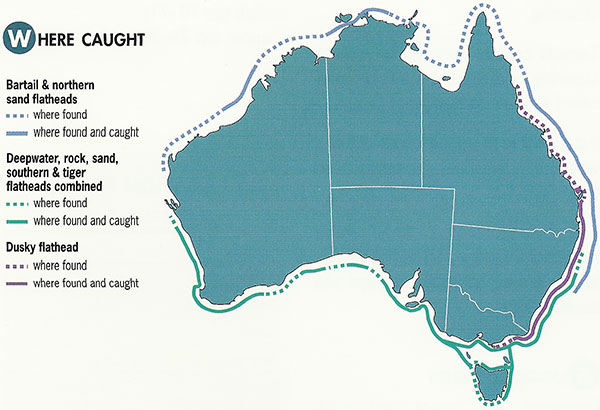Deepwater flathead are superb table fishes, with finely textured flesh. The use of a sauce or marinade adds to the flavour and texture.
They are a popular choice for traditional preparation of a light battering, and served with chips and tartare or mayonnaise.
Download our species guide on common species caught in AFMA managed fisheries.
Catch limits
| Catch limit | Fishing Mortality* | Biomass** |
|---|---|---|
Catch Limit 940 tonnes For the 2025–26 Season | G;Not subject to overfishing | G;Not overfished |
* Fishing mortality status relates to the level of fishing pressure on a stock - specifically, whether fishing mortality in the year being assessed is likely to result in the stock becoming overfished or prevent the stock from rebuilding from an overfished state. If fishing mortality exceeds either of these thresholds, a stock is considered to be subject to overfishing.
** Biomass status relates to how many fish there are - specifically, whether the biomass in the year being assessed is above the level at which the risk to the stock is considered to be unacceptable. The HSP defines this level as the limit reference point, below which the stock is considered to be overfished.
Scientific name: Neoplatycephalus conatus (also known as Platycephalus conatus)
Family: Platycephalidae
Other names: Trawl flathead
Description: Deepwater flathead have a flat triangular shaped head and a long tapering body. They are greenish purple to grey on the back and whitish on the belly. The sides are often blotched grey. The fins are grey and there is a dark blotch on the operculum (the hard bony flap covering the gills).
Size (length and weight): Up to about 95 cm in length and 4 kg. Commonly found at 45‑65 cm and 0.7‑1.8 kg. Females grow larger than males.
Life span: Up to 15-20 years. Females live longer than males.
Habitat: Deepwater flathead are a demersal species that lives on the continental shelf and slope. They can be found at depths of 70-490 metres. They are well camouflaged and spend the majority of their life buried in sand or mud, with just the eyes or upper parts of the head exposed. Deepwater flathead potentially aggregate by gender.
Prey: Small fish, crustaceans, squid, polychaetes, molluscs and echinoderms.
Predators: May include dogfish.
Reproduction: Females reach reproductive maturity at 5-6 years of age, with males maturing at 4-5 years of age. Deepwater flathead aggregate for spawning. Spawning occurs in late spring and summer, but may extend into early autumn. Females produce 0.5‑3.5 million eggs per spawning season.
Other notes: Has been confused with the southern blue-spotted flathead P. speculator until recently.
| Fishery found in | Gear used | Catch of this species is targeted or incidental |
|---|---|---|
| Southern and Eastern Scalefish and Shark Fishery – Great Australian Bight Trawl Sector | Bottom trawl and Danish seine | Targeted |
| Southern and Eastern Scalefish and Shark Fishery – Commonwealth Trawl Sector | Bottom trawl | Incidental |
The Commonwealth catch of deepwater flathead is managed by quota. Which means the catch of this fish by commercial fishers is restricted by weight.
Commercial fishermen are required to fill in records of their catches, during each fishing trip and when they land their catch in a port. This helps us keep records of how much is being caught.
AFMA decide on the amount that can be caught each year from expert advice and recommendations from fisheries managers, industry members, scientist and researchers.
Deepwater flathead are predominantly found in shelf waters at a depth of approximately 120-200metres.
Deepwater flathead are endemic to southern Australian waters.
Catches of this species peak in October – December.

Deepwater flathead are caught using trawl nets and Danish seine nets.
Sometimes, bottom trawling can catch unwanted species of fish (not the type of fish the net was supposed to catch). This is known as bycatch and it is monitored by on-board fishery observers who assess the environmental impact of the trawling.
Although it is not physically possible to trawl on reef structures, significant long-term damage can occur if sensitive habitat areas like corals, sponges and seagrass beds are trawled. To ensure these sensitive habitat areas are protected from trawling, management arrangements such as area closures are extensively used.
There are a number of management arrangements and strategies used with the aim to reduce the impact of fishing on the environment. In the Great Australian Bight Sector, this includes:
- minimum mesh sizes for bottom trawls to reduce the catch of small and juvenile fish
- mitigation devices to reduce interactions with threatened, endangered and protected species
- and closing areas to fishing to protect vulnerable species and habitats.
AFMA carries out ecological risk assessments for all of its major fisheries. AFMA mitigates or reduces that impact through its ecological risk management strategy.
Gear
Want to know more?
This is just an overview of deepwater flathead, if you want to know more see the links below.
This fish is managed under the Southern and Eastern Scalefish and Shark Fishery.